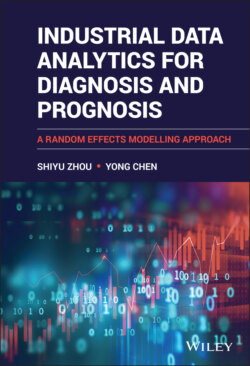Читать книгу Industrial Data Analytics for Diagnosis and Prognosis - Yong Chen - Страница 5
Contents
Оглавление1 Cover
2 Title page
3 Copyright
4 Dedication
5 Preface
6 Acknowledgments
7 Acronyms
8 Table of Notation
9 Chapter 1: Introduction1.1 Background and Motivation1.2 Scope and Organization of the Book1.3 How to Use This BookBibliographic Notes
10 Part 1 Statistical Methods and Foundation for Industrial Data AnalyticsChapter 2: Introduction to Data Visualization and Characterization2.1 Data Visualization2.1.1 Distribution Plots for a Single Variable2.1.2 Plots for Relationship Between Two Variables2.1.3 Plots for More than Two Variables2.2 Summary Statistics2.2.1 Sample Mean, Variance, and Covariance2.2.2 Sample Mean Vector and Sample Covariance Matrix2.2.3 Linear Combination of VariablesBibliographic NotesExercisesChapter 3: Random Vectors and the Multivariate Normal Distribution3.1 Random Vectors3.2 Density Function and Properties of Multivariate Normal Distribution3.3 Maximum Likelihood Estimation for Multivariate Normal Distribution3.4 Hypothesis Testing on Mean Vectors3.5 Bayesian Inference for Normal DistributionBibliographic NotesExercisesChapter 4: Explaining Covariance Structure: Principal Components4.1 Introduction to Principal Component Analysis4.1.1 Principal Components for More Than Two Variables4.1.2 PCA with Data Normalization4.1.3 Visualization of Principal Components4.1.4 Number of Principal Components to Retain4.2 Mathematical Formulation of Principal Components4.2.1 Proportion of Variance Explained4.2.2 Principal Components Obtained from the Correlation Matrix4.3 Geometric Interpretation of Principal Components4.3.1 Interpretation Based on Rotation4.3.2 Interpretation Based on Low-Dimensional ApproximationBibliographic NotesExercisesChapter 5: Linear Model for Numerical and Categorical Response Variables5.1 Numerical Response – Linear Regression Models5.1.1 General Formulation of Linear Regression Model5.1.2 Significance and Interpretation of Regression Coefficients5.1.3 Other Types of Predictors in Linear Models5.2 Estimation and Inferences of Model Parameters for Linear Regression5.2.1 Least Squares Estimation5.2.2 Maximum Likelihood Estimation5.2.3 Variable Selection in Linear Regression5.2.4 Hypothesis Testing5.3 Categorical Response – Logistic Regression Model5.3.1 General Formulation of Logistic Regression Model5.3.2 Significance and Interpretation of Model Coefficients5.3.3 Maximum Likelihood Estimation for Logistic RegressionBibliographic NotesExercisesChapter 6: Linear Mixed Effects Model6.1 Model Structure6.2 Parameter Estimation for LME Model6.2.1 Maximum Likelihood Estimation Method6.2.2 Distribution-Free Estimation Methods6.3 Hypothesis Testing6.3.1 Testing for Fixed Effects6.3.2 Testing for Variance–Covariance ParametersBibliographic NotesExercises
11 Part 2 Random Effects Approaches for Diagnosis and PrognosisChapter 7: Diagnosis of Variation Source Using PCA7.1 Linking Variation Sources to PCA7.2 Diagnosis of Single Variation Source7.3 Diagnosis of Multiple Variation Sources7.4 Data Driven Method for Diagnosing Variation SourcesBibliographic NotesExercisesChapter 8: Diagnosis of Variation Sources Through Random Effects Estimation8.1 Estimation of Variance Components8.2 Properties of Variation Source Estimators8.3 Performance Comparison of Variance Component EstimatorsBibliographic NotesExercisesChapter 9: Analysis of System Diagnosability9.1 Diagnosability of Linear Mixed Effects Model9.2 Minimal Diagnosable Class9.3 Measurement System Evaluation Based on System DiagnosabilityBibliographic NotesExercisesAppendixChapter 10: Prognosis Through Mixed Effects Models for Longitudinal Data10.1 Mixed Effects Model for Longitudinal Data10.2 Random Effects Estimation and Prediction for an Individual Unit10.3 Estimation of Time-to-Failure Distribution10.4 Mixed Effects Model with Mixture Prior Distribution10.4.1 Mixture Distribution10.4.2 Mixed Effects Model with Mixture Prior for Longitudinal Data10.5 Recursive Estimation of Random Effects Using Kalman Filter10.5.1 Introduction to the Kalman Filter10.5.2 Random Effects Estimation Using the Kalman FilterBiographical NotesExercisesAppendixChapter 11: Prognosis Using Gaussian Process Model11.1 Introduction to Gaussian Process Model11.2 GP Parameter Estimation and GP Based Prediction11.3 Pairwise Gaussian Process Model11.3.1 Introduction to Multi-output Gaussian Process11.3.2 Pairwise GP Modeling Through Convolution Process11.4 Multiple Output Gaussian Process for Multiple Signals11.4.1 Model Structure11.4.2 Model Parameter Estimation and Prediction11.4.3 Time-to-Failure Distribution Based on GP PredictionsBibliographical NotesExercisesChapter 12: Prognosis Through Mixed Effects Models for Time-to-Event Data12.1 Models for Time-to-Event Data Without Covariates12.1.1 Parametric Models for Time-to-Event Data12.1.2 Non-parametric Models for Time-to-Event Data12.2 Survival Regression Models12.2.1 Cox PH Model with Fixed Covariates12.2.2 Cox PH Model with Time Varying Covariates12.2.3 Assessing Goodness of Fit12.3 Joint Modeling of Time-to-Event Data and Longitudinal Data12.3.1 Structure of Joint Model and Parameter Estimation12.3.2 Online Event Prediction for a New Unit12.4 Cox PH Model with Frailty Term for Recurrent EventsBibliographical NotesExercisesAppendix
12 Appendix: Basics of Vectors, Matrices, and Linear Vector Space
13 References
14 Index
